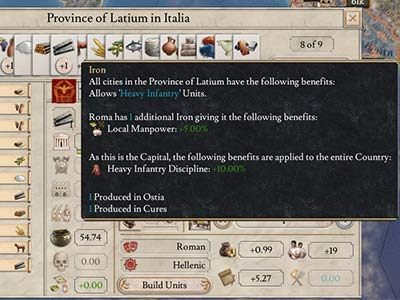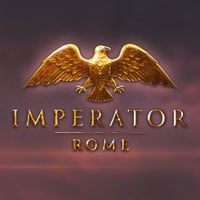Land units in Imperator Rome - types and tips
Last update:
In Imperator: Rome, you can recruit several types of military units that can give you an advantage on the battlefield.
To recruit certain types of troops you need strategic resources, without which you're not able to form new units or replenish your losses. Surplus strategic resources will provide bonuses for a given type of military units. Formation of some units is not possible if you do not have a proper military tradition, e.g. barbarian traditions can provide chariots. Often, specific traditions are focused on 1-2 types of military units, so that such units are stronger and fight better. It's worth to create armies based on such units in order to maximize their benefits and bonuses.

Each nation has the same bonuses and penalties for military units, but some of them have unique modifiers that result from tradition, resource trading or special events. Therefore, whenever you see a particular type of forces, you can expect virtually the same effects as troops of the same type of your nation.
Units differ in terms of cost of recruitment and maintenance. Some of them have different unit weight, e.g. light infantry has -50% and elephants 300%. So, one war elephant unit "weighs" as much as three regular units. This is important to providing supplies for the army. Although your armies may have a similar number of units, an army composed of light infantry will need less supplies and a formation with a large number of war elephants will consume more supply points. Units vary by name depending on the region, but this is a purely cosmetic difference.

All nations have access to each type of military unit, assuming they have the necessary resources. The names are different for each nation, but it's a cosmetic difference. The screenshot presents Roman units.
Imperator: Rome features the following types of units.
- Archers. These are light units, which are good at dealing with light infantry, but have some trouble with cavalry. These are the cheapest units, which are available without any additional costs or strategic resources.
- Camels. These are fast units that focus on the fighting light units and archers. You need camels to recruit them. They are agile, making them ideal units to put on the flank.
- Chariots. These are powerful units that have a big bonus against light infantry, but are less effective against other types of enemies, especially heavy infantry and elephants. Only some traditions can create this type of units.
- Heavy Cavalry. This is one of the best units because it has a bonus against almost all light units, except battle elephants. It requires horses and consumes twice as much supplies as the rest of the units. It's faster than infantry units and is suitable for flanking.
- Heavy Infantry. In countries with Greek or Italian traditions, these are the basic units that require iron. They have an advantage over many infantry and heavy cavalry units, but they are not very good at fighting horses.
- Horse Archers. The perfect unit to fight both types of infantry and chariots. On the other hand, it needs a supply of steppe horses.
- Light Cavalry. This cavalry unit still has a lot of bonuses, similar as heavy cavalry, but it's very weak against heavy infantry and elephants. It's faster and better for flanking maneuvers than heavy cavalry.
- Light Infantry. This is one of the cheapest and most common units. It's not very good at against almost all types of units, but it consumes less supplies. It has a bonus that gives them additional morale and enables them to last longer in a fight.
- War Elephants. They have a devastating bonus against all infantry units. In addition, they have a special skill that enables them to take less damage. On the other hand, it's an expensive unit in recruitment and maintenance, and needs three times more supplies. Elephants often tip the scales of a battle, and can defeat even more numerous armies.
Attention: Only archers, light and heavy infantry can take part in the assault on forts, but all units count for the siege.
The right composition of your armies is often the key to victory. Try to match your troops to your tactics. This way, you'll not only get a bigger bonus, but you'll also be able to create an appropriately sized army more easier. It's worthwhile to have a few camps with different types of troops. You can use the following outlines:
- Most armies will work fine with a composition of 2/3 infantry and 1/3 cavalry, which will flank the enemy. A mix of light and heavy infantry will help to increase the effectiveness of the army against various enemy units.
- When playing the Mediterranean countries, we recommend the following composition: 1/3 archers or horse archers, 1/3 heavy infantry, 1/3 light infantry/cavalry. This is a universal system that will be able to handle light troops very well.
- If you play as barbarians, it's worth to create an army where the main core is light infantry and 1/4 is chariots and archers. Most of the neighboring nations will base their structure on light infantry, where chariots will be a great counter.
- A cavalry-only army will be faster and suitable for quick attacks and chasing after withdrawing troops. On the other hand, it can be defeated by strong infantry groups.
Avoid creating large armies composed of a single type of units, e.g. only heavy infantry or only elephants. It may seem like you have a significant advantage over other units if you bet on a single type of units. Unfortunately, all you need to defeat such a force is the right army type, a well-chosen tactic and a decent commander. It is better for your army to have a composition. If you have access to horses, you can add several such Cohorts to each structure of your army. Flanking is a very useful maneuver for any army. This way, you will avoid Pyrrhic victories or numerous defeats.
You are not permitted to copy any image, text or info from this page. This site is not associated with and/or endorsed by the Paradox Interactive or Paradox Development Studio. All logos and images are copyrighted by their respective owners.
Copyright © 2000 - 2025 Webedia Polska SA for gamepressure.com, unofficial game guides, walkthroughs, secrets, game tips, maps & strategies for top games.
